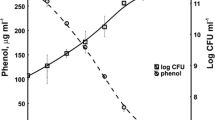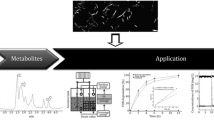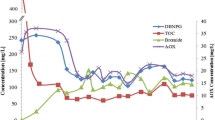Abstract
Bacillus sp. ORAs2 and Pseudomonas sp. ORAs5, two arsenic-resistant bacterial strains previously isolated from sediments of the Orbetello Lagoon, Italy, were tested for their adaptation to mixed contaminants on the level of membrane fatty acid composition. The two bacterial strains were characterized by high levels of arsenic resistance, and Pseudomonas sp. ORAs5 was also shown to be solvent-tolerant. The bacterial strains were exposed to mixtures of two toxic compounds: arsenic at fixed concentrations and toluene in variable amounts or, alternatively, toluene at constant values along with arsenic added at variable concentrations. Both strains react to the contaminants by changing the composition of their membrane fatty acids. Bacillus sp. strain ORAs2 showed a correlation between growth rate decreases and fatty acids degree of saturation increases in both cases, although pointedly in the presence of 1, 2, and 3 mM of toluene and different additions of arsenic, counteracting membranes fluidity induced by toxic compounds. In Pseudomonas sp. ORAs5, adaptive changes in membrane composition was observed both in terms of increases in the degree of saturation and in the trans/cis ratio of unsaturated fatty acids in the presence of varying toluene and constant arsenic concentrations, whereas only minor changes occurred with increasing arsenic and constant toluene concentrations. Thus, on the level of membrane composition, Bacillus sp. ORAs2 showed a higher potential for adaptation to the presence of mixed pollutants, suggesting its probable suitability for bioremediation purposes.



Similar content being viewed by others
References
Bligh EG, Dyer WJ (1959) A rapid method of total lipid extraction and purification. Can J Biochem Physiol 37:911–917
de Carvalho CCCR, Parreňo-Marchante B, Neumann G, da Fonseca MMR, Heipieper HJ (2005) Adaptation of Rhodococcus erythropolis DCL14 to growth on n-alkanes, alcohols and terpenes. Appl Microbiol Biotechnol 67:383–388
Diefenbach R, Keweloh H (1994) Synthesis of trans unsaturated fatty acids in Pseudomonas putida P8 by direct isomerization of the double bond of lipids. Arch Microbiol 162:120–125
Diefenbach R, Heipieper HJ, Keweloh H (1992) The conversion of cis- into trans-unsaturated fatty acids in Pseudomonas putida P8: evidence for a role in the regulation of membrane fluidity. Appl Microbiol Biotechnol 38:382–387
Donati A, Pulselli FM, Riccobono F, Dallai L, Francovich R, Tiezzi E (2005) Origin of arsenic pollution in Southwest Tuscany: comparison of fluvial sediments. Ann Chim 95:161–166
Duxbury T (1985) Ecological aspects of heavy metal responses in microorganisms. Adv Microbiol Ecol 8:185–236
Focardi SE (2005) Relazione tecnico scientifica relativa alla caratterizzazione ambientale dell’area ex Sitoco perimetrazione a mare. Ph.D. thesis. University of Siena, Italy
Frostegård Å, Tunlind A, Bååth E (1993) Phospholipids fatty acid composition, biomass and activity of microbial communities from two soil types exposed to different heavy metals. Appl Environ Microbiol 59:3605–3617
Frostegård Å, Tunlind A, Bååth E (1996) Changes in microbial community structure during long-term incubation in two soil experimentally contaminated with metals. Soil Biol Biochem 28:55–63
Guckert JB, Hood MA, White DC (1986) Phospholipid ester-linked fatty acid profile changes during nutrient deprivation of Vibrio cholerae: increase in the trans/cis ratio and proportions of cyclopropyl fatty acids. Appl Environ Microbiol 52:794–801
Hauser J (1991) Effect of inorganic cations on phase transitions. Chem Phys Lipids 57:309–325
Heipieper HJ, de Bont JAM (1994) Adaptation of Pseudomonas putida S12 to ethanol and toluene at the level of fatty acid composition of membranes. Appl Environ Microbiol 60:4440–4444
Heipieper HJ, Keweloh H, Rehm HJ (1991) Influence of phenols on growth and membrane permeability of free and immobilized Escherichia coli. Appl Environ Microbiol 57:1213–1217
Heipieper HJ, Diefenbach R, Keweloh H (1992) Conversion of cis unsaturated fatty acids to trans, a possible mechanism for the protection of phenol-degrading Pseudomonas putida P8 from substrate toxicity. Appl Environ Microbiol 58:1847–1852
Heipieper HJ, Weber FJ, Sikkema J, Keweloh H, de Bont JAM (1994) Mechanisms behind resistance of whole cells to toxic organic solvents. Trends Biotechnol 12:409–415
Heipieper HJ, Meulenbeld G, VanOirschot Q, de Bont JAM (1996) Effect of environmental factors on the trans/cis ratio of unsaturated fatty acids in Pseudomonas putida S12. Appl Environ Microbiol 62:2773–2777
Heipieper HJ, Meinhardt F, Segura A (2003) The cis-trans isomerase of unsaturated fatty acids in Pseudomonas and Vibrio: biochemistry, molecular biology and physiological function of a unique stress adaptive mechanism. FEMS Microbiol Lett 229:1–7
Kaur A, Chaudhary A, Kaur A, Choudhary R, Kaushik R (2005) Phospholipid fatty acid––a bioindicator of environmental monitoring and assessment in soil ecosystem. Curr Sci 89:1103–1112
Keweloh H, Heipieper HJ (1996) Trans unsaturated fatty acids in bacteria. Lipids 31:129–137
Keweloh H, Diefenbach R, Rehm HJ (1991) Increase of phenol tolerance of Escherichia coli by alterations of the fatty acid composition of the membrane lipids. Arch Microbiol 157:49–53
Killian JA, Fabrie CHJP, Baart W, Morein S, de Kruijff B (1992) Effects of temperature variation and phenethyl alcohol addition on acyl chain order and lipid organization in Escherichia coli derived membrane systems. A 2H- and 31P-NMR study. Biochim Biophys Acta 1105:253–262
MacNaughton SJ, Stephen JR, Venosa AD, Davis GA, Chang YJ, White DC (1999) Microbial population changes during bioremediation of an experimental oil spill. Appl Environ Microbiol 65:3566–3574
Morrison WR, Smith LM (1964) Preparation of fatty acid methyl esters and dimethylacetals from lipids with boron fluoride–methanol. J Lipid Res 5:600-608
Pepi M, Volterrani M, Renzi M, Marvasi M, Gasperini S, Franchi E, Focardi SE (2007) Arsenic-resistant bacteria isolated from contaminated sediments of the Orbetello Lagoon, Italy, and their characterization. J Appl Microbiol 103:2299–2308
Petersen SO, Klug MJ (1994) Effect of sieving, storage, and incubation temperature on the phospholipid fatty acid profile of a soil microbial community. Appl Environ Microbiol 62:2421–2430
Seelig J, Waespe-Šarcevic N (1978) Molecular order in cis and trans unsaturated phospholipids bilayers. Biochemistry 17:3310–3315
Sikkema J, de Bont JAM, Poolman B (1994) Interaction of cyclic hydrocarbons with biological membranes. J Biol Chem 269:8022–8028
Sikkema J, de Bont JAM, Poolman B (1995) Membrane toxicity of cyclic hydrocarbons. Microbiol Rev 59:201–222
Sinensky M (1974) Homeoviscus adaptation–a homeostatic process that regulates the viscosity of membrane lipids in Escherichia coli. Proc Natl Acad Sci USA 71:522–525
Springael D, Diels L, Hooyberghs L, Kreps S, Mergeay M (1993) Construction and characterization of heavy metal-resistant haloaromatic-degrading Alcaligenes eutrophus strains. Appl Environ Microbiol 59:334–339
Stahlberg H, Brown T, de Groot B, Philippen A, Borgnia MJ, Agre P, Kuhlbrandt W, Engel A (2000) The 6.9Å structure of GlpF: a basis for homology modelling of the glycerol channel from Escherichia coli. J Struct Biol 132:133–141
Suutari M, Laakso S (1974) Microbial fatty acids and thermal adaptation. Crit Rev Microbiol 20:285–328
van de Vossenberg JLCM, Driessen AJM, da Costa MS, Konings WN (1999) Homeostasis of the membrane proton permeability in Bacillus subtilis grown at different temperatures. Biochim Biophys Acta 1419:97–104
von Wallbrunn A, Richnow HH, Neumann G, Meinhardt F, Heipieper HJ (2003) Mechanism of cis–trans isomerization of unsaturated fatty acids in Pseudomonas putida. J Bacteriol 185:1730–1733
Weber FJ, de Bont JAM (1996) Adaptation mechanisms of microorganisms to the toxic effects of organic solvent on membranes. Biochim Biophys Acta 1286:225–245
Weber FJ, Isken S, de Bont JAM (1994) Cis/trans isomerization of fatty acids as a defence mechanism of Pseudomonas putida strains to toxic concentrations of toluene. Microbiology 140:2013–2017
Acknowledgments
This work was supported by a grant from the Fondazione Monte dei Paschi di Siena as well as by the European Commission within its Sixth Framework Program project BIOTOOL (Contract No. 003998, GOCE).
Author information
Authors and Affiliations
Corresponding author
Additional information
Communicated by K. Horikoshi.
Rights and permissions
About this article
Cite this article
Pepi, M., Heipieper, H.J., Fischer, J. et al. Membrane fatty acids adaptive profile in the simultaneous presence of arsenic and toluene in Bacillus sp. ORAs2 and Pseudomonas sp. ORAs5 strains. Extremophiles 12, 343–349 (2008). https://doi.org/10.1007/s00792-008-0147-9
Received:
Accepted:
Published:
Issue Date:
DOI: https://doi.org/10.1007/s00792-008-0147-9




